Social media and SEO. It's one of the hottest topics among marketers ...
... and also one of the most misunderstood.
As Google continues to say that social media doesn’t impact SEO, many marketers are left wondering if there's a direct connection.
The good news? There is!
A recent study conducted by Search Metrics shows the correlation.
So where do you begin?
Instead of wishing for a way to increase traffic and engagement, I'll show you how to stop hurting your SEO with a social media strategy that works!
Failing to Maximize Your Social Media Profiles
Try Googling your name as well as the name of your business. If the only thing you see is a link to your website, you might have a profile issue.
But I get it.
You were so busy getting down to the business of sharing content on social media, you ignored the potential within your profile.
The good news? We can fix it!
Here's a few tips:
- Use the same profile picture in all of your social media accounts
- Link to your website as well as other social media pages
- Insert relevant keywords in your bio and other information that potential customers would search for when researching your company
To further draw the connection between your website and social pages, use markups to get Google to display your social media information in search results.
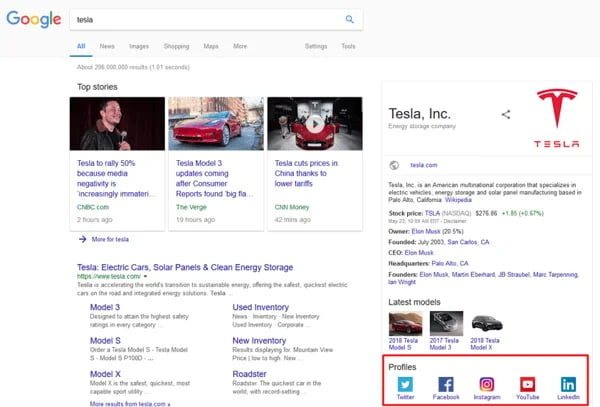
You also want to make it a practice to revisit your social media profiles each month. This gives you an excuse to stay on top of your social media accounts and the information included.
You can make profile changes you’ve neglected such as an old phone number or outdated address.
An added bonus is that it ensures that you catch suspicious activity, respond to messages, and engage with your followers.
Even if you have a team member handling a particular platform, you should keep a personal eye on them.
You Believe That Collecting Followers Will Boost SEO
Google officially says they don't measure social signals. But unofficially? The legitimacy of your account is important.
Think about it, why would Google be interested in a bot? Or impressed with the number of followers you have?
Those numbers are too easy to fake. Followers can be bought. Friends, family, and coworkers can be encouraged to like and share content.
Of course then, there are the bots. If you're paying for followers, there's a chance that you'll be connected with live, active posters.
Unfortunately, the chances of this are slim. It’s too easy for a company to auto create multiple profiles with different demographic data, interests, etc.
That won’t lead to engagement and worse yet, if enough people notice that a great number of your followers are bots, it can be damaging. You might:
- Have your social media account flagged
- Have your reputation damaged
- Lose access to your social media account
- Lose followers
- Waste time on low quality audience members
Even if your paid followers are real, that’s still problematic.They likely feel no obligation to engage with you or share your content.
/Picture2.png?width=499&name=Picture2.png)
A fake Twitter profile, created by company Devumi
Image source: New York Times
Bottom line is this. It’s nice to have a lot of followers.
Just remember that without engagement, none of it matters.
10K followers may seem like a lot, but that number becomes meaningless if more than half of them are fake or haven’t read your posts in a year.
It takes time to earn followers, but the process is worthwhile.
DOWNLOAD: Ready to navigate the Facebook algorithm in 2018? Grab a free copy of our easy to follow guide!
You Aren’t Sharing Content That Drives Links
Because there isn’t a direct connection between social media and SEO, analytics won’t tell you when the traffic you are receiving is being driven by links you have earned thanks to your social media pages.
In spite of this, you simply have to take a leap of faith and believe.
Well, have faith and employ a lot of common sense. After all, it's pretty rare to find a content writer or digital marketer who doesn’t regularly link to content they originally found on social media.
Remember that the same thing that drives you to click on links in social media is the same thing that drives everyone else.
It starts with a great, promotional post. Here's an example:
- You write an article for an industry publication
- You publish a post on a business associate’s website
- You finish up an amazing white paper, that's great content that can lead to both traffic and links if you promote it correctly like, social media strategist Peg Fitzpatrick
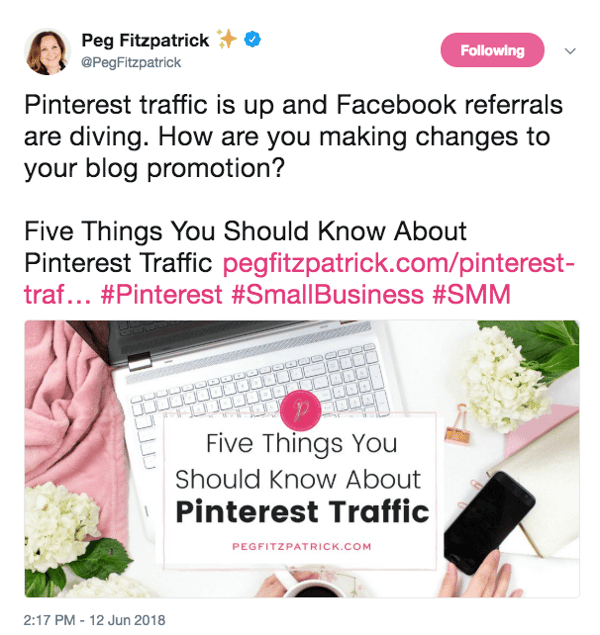
Unfortunately, most people don’t do that. Instead, they create stale posts that do nothing to generate any excitement.
They usually look like this:
- New post on the blog today. Check it out!
- Click here to read the article I wrote for FakeURL.com
- Thanks to my friend Bob for letting me share my thoughts with his audience. Click here.
That’s not just boring. It’s ineffective. Instead, add a teaser to the content before you link. A quote from the article works well.
Selling your audience on the benefits of clicking can help as well.
Let’s say you’ve published something on the benefits of a low carb diet. Your selling point isn’t that people can learn about this diet. It’s what they can do with the knowledge.
Earn links by posting something like this:
- Learn to adopt a diet plan where you never feel hungry.
- Eat like a king and still lose weight.
- Ditch the side dishes and eat more of the main course.
- Become a fat burning machine.
- Get more gains in the gym
- Lose weight and build muscle before summer.
- Learn how kicking carbs can lead to faster and more sustained weight loss.
Get people interested. You can do this by selling them on the benefits of your content.
Come through for them, and it will be easier to earn clicks and then links every time.
Remember this old quote?
“People don’t want to buy a quarter inch drill. They want a quarter inch hole.”
Theodore Levitt is still right.
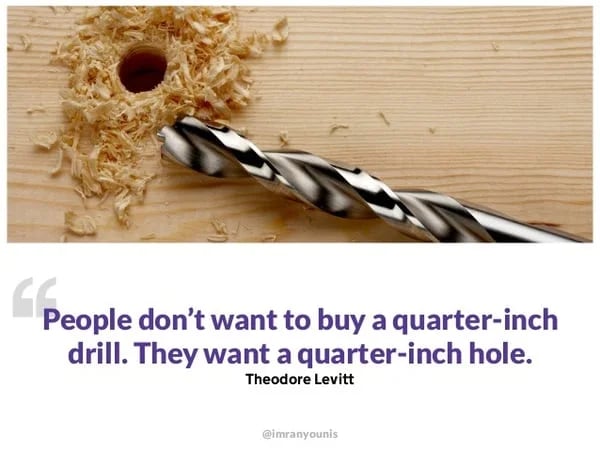
Next, be consistent. It does no good to post interesting content every once in a while. Your audience has to be able to rely on you to post things that they find worth sharing.
Another common mistake of social media managers is failing to check the quality of content. As a result, you get poor engagement, low brand recognition, and waste time fixing everything instead of doing it beforehand.
A few tools to help you keep everything organized...
Finally, work hard at building social relationships with influencers and brand ambassadors. Shares are great.
When they come from someone with influence or who is enthusiastic about your brand, that is even better.
Ultimately, it’s a simple concept. The more shares and engagement you get, the more likely your post will lead to someone actually linking your content within their own.
Earn those shares by using social media to truly sell your content and expertise.
Your Content Isn’t Targeting Customers at All Points in The Sales Funnel
At any given time, you have followers on social who are at different points in the sales funnel.
If your social content only focuses on high or low funnel customers, you miss the opportunity to reach out to people who are interested in engaging with you.
Here are some guidelines for posting content for all stages of the sales funnel.
Understanding The Sales Funnel
Although reality is a bit different, it’s safe to think of the sales funnel as having three stages. The top consists of customers who aren’t quite ready to make a purchase.
They're interested in gathering information and getting to know companies that might do business with.
The next stage is the middle of the funnel.
These are the customers who know they want to make a purchase. They're in the process of evaluating your products and services.
Finally, there are customers at the bottom of the funnel. They're ready to buy, and have decided you are likely who they want to do business with.
Great Top of Funnel Content
First, top of funnel customers want to get to know your company.
- What is your brand?
- Are you trustworthy?
- What exactly do you have to offer?
To attract them, post links that teach about your company’s history and mission.
Share content about the products and services you have available, but keep it at an introductory level. Post videos and photos of your team.
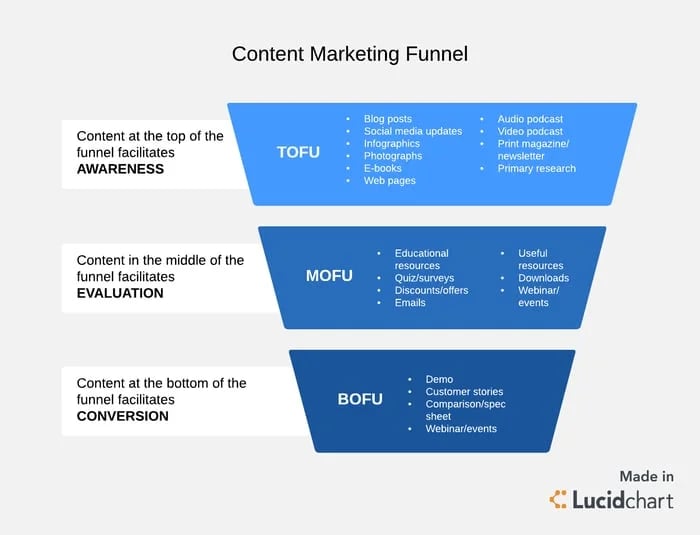
Reaching Mid Funnel Customers
These folks want details. Share product demonstration videos. Link to white papers. Promote user generated content like customer reviews and testimonials.
This is also the stage to really pay attention to engagement.
Mid funnel customers are deciding whether or not you're the company for them.
Being available to answer questions or simply share information can earn SEO boosting engagement as well as sales.
Closing The Deal at The Bottom of The Funnel
Here it's important to focus on making the last stages of the process easy.
However, content can still help.
Share case studies that prove increased savings and improved productivity.
You Don’t Make Sharing Easy Enough
It isn’t just your social media that can correlate with higher rankings. Your followers can as well.
Any time someone hits a social share button on your website or blog, your content reaches a wider audience.
That can lead to more shares, website traffic, links, and other behaviors that do improve SEO.
The only problem is that too many people make sharing a chore, or they don’t do enough to build the trust that leads to shares.
Here are a few things to try:
- Use social share buttons with counters
- Include a call to action to encourage sharing
- Make social sharing mobile friendly
- Use the ‘Click to Tweet’ feature
- Know who consistently shares your content and reciprocate
- A/B test social share buttons and positions
You might also consider using an incentive for getting people to share your content. For example, you can create a social media or hashtag contest like this one from T-Mobile.

Each time someone shares your content on social media and then tags your company or uses a specific hashtag, they can earn entry into a giveaway.
You can also reward prizes to the first XX number of people to like and share a post that you need to gain traction.
Conclusion
Never assume that your activity and engagement on social media doesn’t impact SEO. It does. Google and other search engines may not track this directly.
However, as long as social media is a place where you can build relationships, share content, and earn engagement it will have an impact.
Also, with search engines continually changing their algorithms and improving their functionality, there is no guarantee that social signals won’t have an impact in the future.
In fact, back in 2010 a Google Webmasters Q&A session indicated that the company was beginning to experiment with social signals.
Use social media to get your name and business name to the top of search engine results. Publish and promote content that will lead to links and traffic.
Focus on quality followers, not quantity. Take advantage of the opportunity to use your account profiles to add information that impacts rankings and drives traffic to your website.
By doing all of the above, you can avoid missing out on opportunities to use your social media as a tool for boosting SEO.
/Amanda.jpg?noresize)
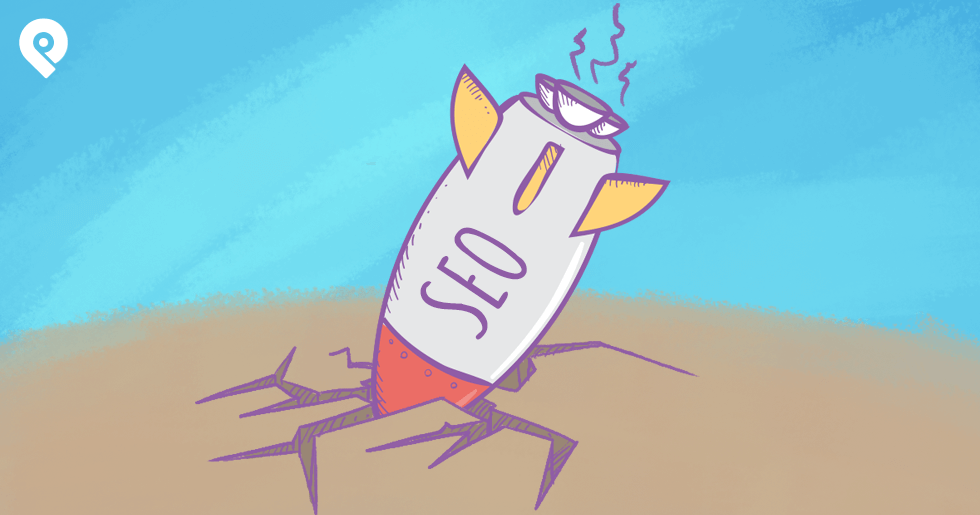






ViewHide comment (1)